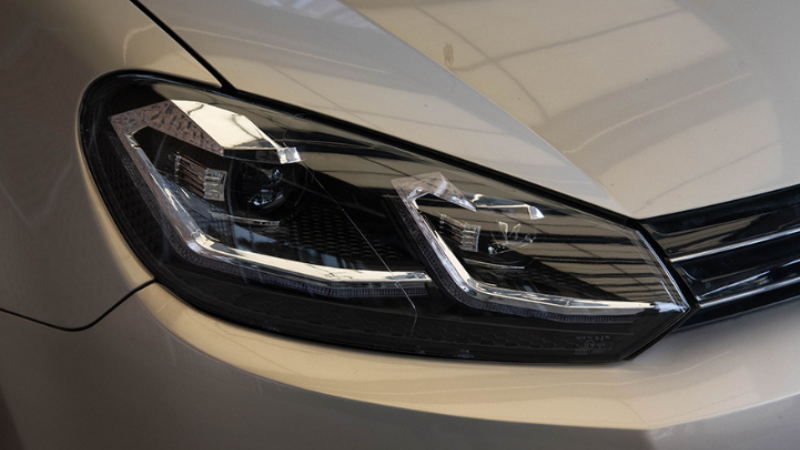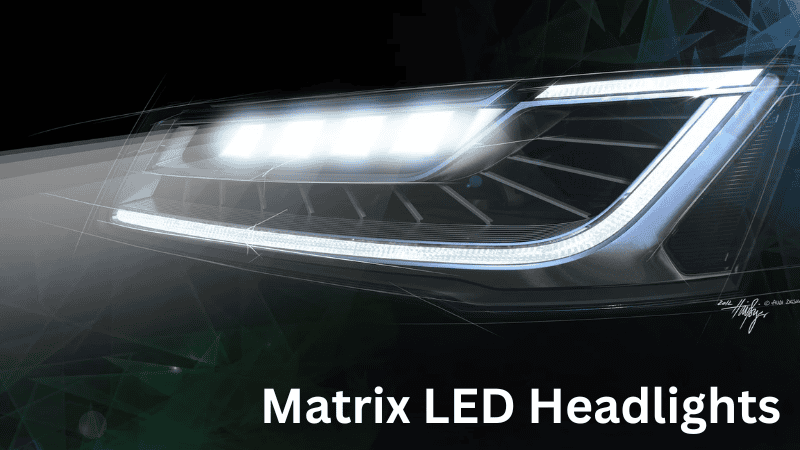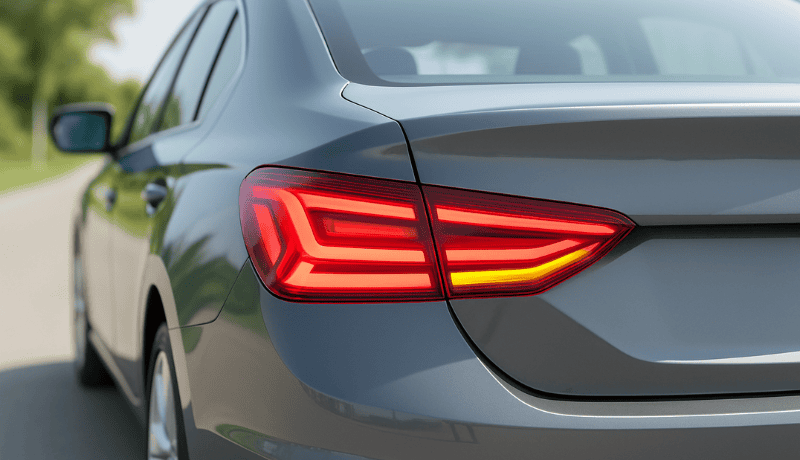Matrix LED headlights are becoming a common option in new cars, promising to eliminate the glare problems associated with bright headlights. This new option does make the selection process confusing, and some may assume it’s just another gimmick.
However, matrix LED headlights are not a gimmick. This technology improves the driving experience for you and other drivers and will improve night driving safety.
In this article, we unpack the workings of matrix LED headlights, explaining how they differ from and surpass normal LED lights. We’ll also look at the tech’s new features and how automakers are implementing it in their cars. Uncover the mysteries of matrix LED headlights below.
What are Matrix LED Headlights?

Matrix LED headlights are headlights made up of multiple, individual light sources. These light sources are light-emitting diodes (LEDs), which can also be augmented with many tiny mirrors or lenses to improve the accuracy of light distribution.
Each light-emitting diode in a matrix headlight can be individually controlled. They can be off, on, or dimmed.
The goal is to be able to dim or turn off specific LEDs while keeping others at full brightness. As a result, the parts of the beam that would cause glare to oncoming drivers can be off or dim while the others remain at full brightness.
The advantage of matrix LED headlights to other drivers is that the light from your full beams won’t be in their faces or reflecting off their mirrors. The advantage for you is that the road ahead and around you will always be well-illuminated.
How do Matrix LED Systems Work?

When the lighting control is set to the adaptive lighting beam, the system uses an onboard camera to detect the light from the headlights of an oncoming car or the taillights of those ahead of you. When none are detected, the light intensity remains at maximum.
When the light from another car is detected, the information is sent to the onboard computer, which calculates its position. The system determines which LEDs should be turned off or dimmed to eliminate the part of the beam that would be cast on the other car.
In this dynamic process, the position of the other car is constantly recalculated. Different LEDs are turned on and off to keep up with the car’s position until it’s passed.
Matrix lighting is only possible with LED technology due to the responsiveness required to maintain maximum illumination levels while shading a moving target. In some vehicles, the matrix LED systems can shade as many as five vehicles at the same time.

Matrix LED Headlights Vs Normal LED Headlights
The table below summarizes the key differences between regular LED headlights and matrix LED headlights.
| Feature | Normal LED Headlights | Matrix LED Headlights |
|---|---|---|
| Light Output | Bright, fixed beam | Adaptive, adjustable beam |
| Beam Control | Static high/low switch | Dynamic pixel control, glare-free high beam |
| Visibility Range | Wider than halogen, but limited | Optimized illumination with extended range |
| Safety | Better than halogen, limited adjustability | Enhanced with obstacle recognition & adaptive dimming |
| Technology Level | Basic LED chips with reflectors/projectors | Advanced with individually controlled LED segments |
| Energy Efficiency | Efficient, constant output | Efficient with smarter adaptive usage |
| Cost | Lower cost, widely available | Higher cost, premium segment |
| Maintenance | Easy replacement, low cost | Complex system, higher replacement cost |
| Compliance | Standard LED regulations | Advanced compliance, DOT/ECE certified |
| Aesthetic Impact | Modern, whiter light | Premium look, high-tech design |
Matrix headlights share the same basic illumination technology as normal LED headlights. However, the implementation is different, and so are the results.
1. Number of Light Sources
Regular LED headlights use bulbs that imitate the point source found in halogen bulbs. As a result, they can have as few as two LEDs per headlight.
On the other hand, matrix LED technology needs many individual light sources for its adaptive beams. Each headlight may have tens or even thousands of individual light sources. For example, Porsche makes headlights with over 16,000 micro-LEDs.
2. Illumination Around Other Cars

Normal LED headlights can be bright and offer great illumination at maximum brightness. However, around other cars, the low beams must be activated. This reduces the amount of light from the whole headlight.
Around other cars, matrix LED headlights remain at full brightness, with only parts of the beam that would fall on other cars being cut off. The result is maximum illumination everywhere else.
3. Glare
The high beam headlight setting in regular LED headlights will cause glare to other road users. This risk is even present in some cars when the low beams are on because the system isn’t smart enough to make adjustments based on the positions of other cars.
Matrix LED headlights are unlikely to cause glare even with high beams because the smart system identifies the positions of other cars and dynamically shades them out.
4. Control

Some cars’ headlights have automatic high beams. This automatically switches from high to low beam or vice versa, depending on traffic conditions and speed. In most cases, drivers still manually switch between the two settings.
Although they come with the option of manually adjusting light beams, matrix LED headlights offer a completely hands-off experience. The change in the light beam might even be invisible to the driver.
5. Cost and Ease of Replacement
Regular LED headlights are affordable today. Replacing them can be challenging, but it is often a plug-and-play experience since only the bulb is replaced.
Matrix LED systems are new to the market. They come with advanced features that require better hardware and software. It costs a lot to upgrade to these headlights in a new car, and replacing them is neither cheap nor easy.
Advantages of Matrix LED Headlights
Some of the advantages of matrix LED headlights vs regular headlights are:
- Safety: Drivers can drive under optimal illumination, and glare from their lights won’t affect others. This makes night driving safer for everyone on the road.
- Comfort and convenience: Drivers will find it easier to see with matrix LED headlights because some LEDs will always be at full brightness. They also won’t have to adjust light settings manually. This will be both comfortable and convenient.
- Aesthetics: Matrix LED headlights look more stylish, especially on modern cars.
- Durability: These headlights are based on LED lighting technology, which is more durable than other lighting technologies. Thus, the long-term cost of lighting may be lower.
Additional Features and Functionalities

Matrix LED headlights make it possible to achieve a lot more with automotive lighting. Some of the features already available include:
- Speed Sensitivity: In some cars, the beam range increases when the vehicle passes a certain speed threshold. This gives drivers more time to respond to hazards at high speeds.
- Image and animation projection: The multiple light sources make it possible to project different shapes on roads and walls using the headlights. These can project crosswalks, road signs, and other useful imagery.
- Lane illumination: With this feature, the headlights highlight the lane the driver is on. This can be especially useful when the road is narrow, e.g., due to roadworks.
- Pedestrian identification: This system flashes a bright light at pedestrians or animals about to step onto the road. This serves to both warn them and alert the driver to their presence.
- Vanity lighting: These are fancy animations that can be projected when the driver enters or exits the car.
Real-World Applications of Matrix LED Headlights
Many automakers are adding matrix LED headlights to their vehicles, especially high-end models. Some examples of these implementations are highlighted below.
1. Audi

Audi’s HD Matrix LED headlight has 32 LEDs in each headlamp, but the even newer Digital Matrix LED has a chip with one million microscopic mirrors added that greatly improves resolution.
The system can project a light carpet that shows you the width of your car inside the lane, making it easier to size up small spaces. The headlights can also project animations.
2. Land Rover
Some models of the Range Rover Sport now come with matrix LED headlights as the default lighting option. These can also be upgraded to their Pixel LED headlights, which feature even finer control of the light beam.
Their matrix LED headlight splits the beam into small vertical sections that can be individually turned off, while the Pixel LED headlights split the beam into vertical and horizontal sections.
The adaptive lighting beam is activated when the vehicle speed reaches 40 km/h.
3. Peugeot

The 2021 Peugeot 308 has a matrix module with 20 LEDs. The car’s onboard camera is used to analyze the environment to adapt the light from the various LEDs. The system switches to main beam mode at speeds above 50 km/h.
At speeds above 110km/h, the main beam’s angle is adjusted to illuminate even farther ahead.
Conclusion
Matrix LED headlights have made it possible to have front lighting that is bright yet glare-free. This is an important step in the evolution of automotive lighting systems. Car makers are embracing the technology, and it’s already the default headlight option for some car models.
The main advantage of Matrix LED headlights is safety, but these lights also offer a convenient hands-off experience and extra features that can be both useful and entertaining. As these headlights become common, night driving will undoubtedly become a better experience.
Discover Matrix LED Headlight Technology With Carlightvision
Manufacturing matrix LED headlights requires quality components and a high degree of expertise. You can get all that at Carlightvision.
With over 15 years of experience manufacturing OEM and ODM lighting solutions, plus many hours of lighting research, we can help you transition to this next stage of the headlight evolution. Contact us today and talk to our experts about your Matrix LED headlight needs.




